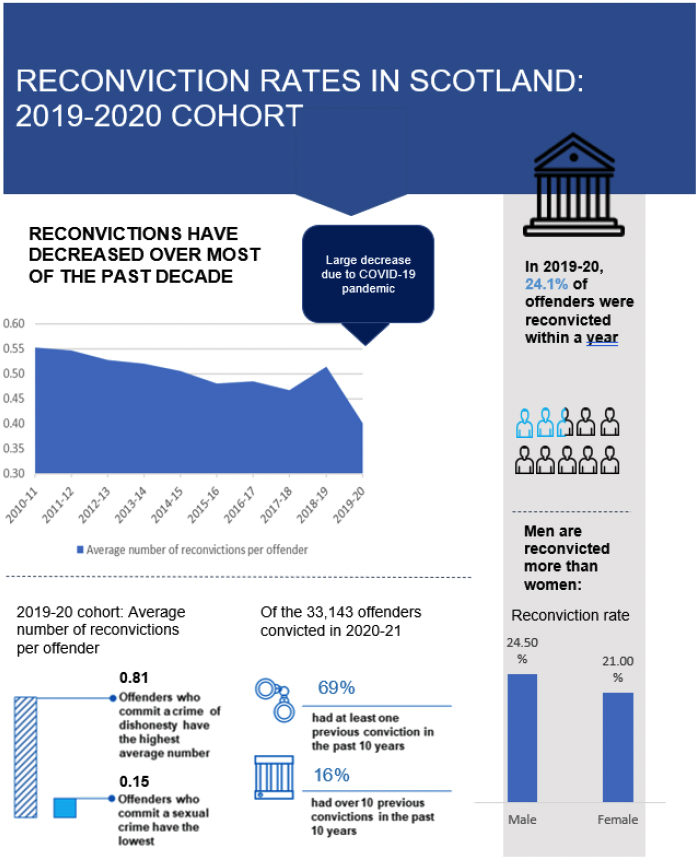Reconviction Rates in Scotland: 2019-20 Offender Cohort
Statistics on reconvictions are presented up to the latest cohort of 2019-20. The latest year’s data is impacted by the COVID-19 pandemic and should not be interpreted to be indicative of longer term trends.
Key points
- The reconviction rate decreased by 4.5 percentage points over the last year from 28.6% in 2018-19 to 24.1% in 2019-20. The average number of reconvictions per offender decreased by 22% in the same period from 0.51 to 0.40 (Table 1).
- There were decreases in both measures of reconvictions over the past year across almost all the different groupings presented in this bulletin.
- After last year's slight increase, the decrease in the reconviction rate and average number of reconvictions per offender continues the trend seen in most years over the past decade. However, the most recent figures are still lower than those ten years ago. Between 2010-11 and 2019-20, the reconviction rate has fallen by 6.1 percentage points from 30.1% to 24.1%, and the average number of reconvictions per offender has decreased by 27% from 0.55 to 0.40. (Table 1).
- Males are reconvicted more often, on average, than females. In 2019-20, the average number of reconvictions per offender for males was 0.41, which was 13% higher than the value of 0.36 for females (Table 2).
- All age-sex combinations saw a decrease in both measures of reconvictions in the past year (Table 4 and Table 5).
- As in previous years, offenders who committed a crime of dishonesty had the highest reconviction rate (40.2% in 2019-20), compared to offenders that committed another type of crime. Offenders who committed a sexual crime had the lowest (10.8% in 2019-20) (Table 6).
- Although lower than other crimes, offenders who committed a sexual crime saw an increase in the reconviction rate from the previous year by 0.2 percentage points (Table 6), the only increase for court disposals in this publication. One potential reason for this increase is that the cohort size for this crime is relatively small, meaning a small change would have a greater effect on percentages compared to larger cohorts.
- 5.5% of offenders with an index domestic abuse crime or offence in 2019-20 were reconvicted for a further domestic abuse crime or offence (Table 8a), and 15.0% were reconvicted for any crime or offence.
- Offenders released from a custodial sentence had an average number of reconvictions per offender of 0.70 in 2019-20, which was 16% lower than 0.83 in 2018-19 (Table 9). Short custodial sentences have higher reconvictions than longer sentences. This is largely because offenders who are given shorter sentences commit relatively less serious crimes, and tend to commit more of these crimes than those committing more serious crimes. Therefore, they are reconvicted more often. In 2019-20 the average number of reconvictions per offender for custodial sentences of three months or less was 1.08, compared to 0.06 for those over four years (Table 10a).
- Community Payback Orders (CPOs) are the most commonly used community sentence. The reconviction rate was 25.1% in 2019-20, a decrease from the stable rates of previous years. The cohort size for CPOs had its first increase from the previous year since 2014-15, although still the second smallest since 2012-13 (Table 9).
- 15% of individuals given a non-court disposal by the police in 2019-20 (such as a warning or fine) received another non-court disposal within a year (Table 19).

Contact
Email: justice_analysts@gov.scot
There is a problem
Thanks for your feedback